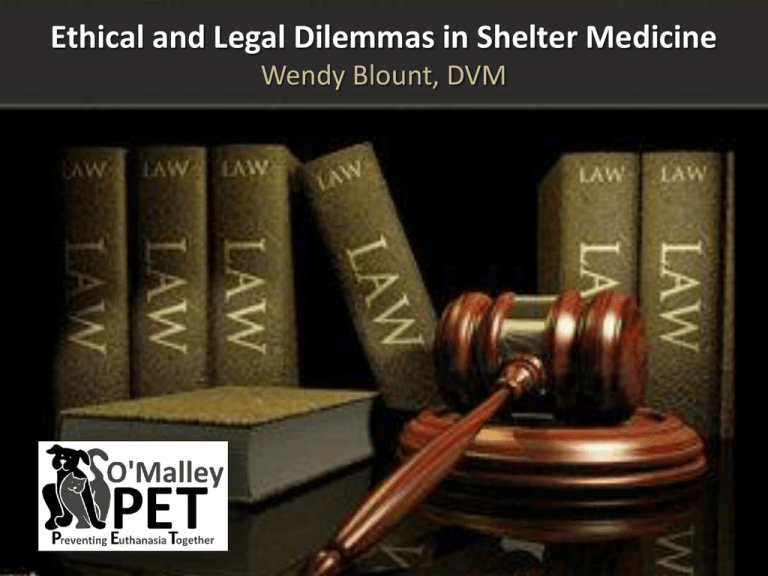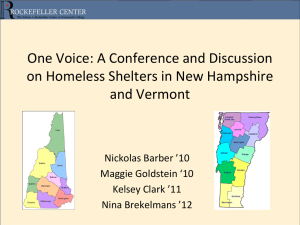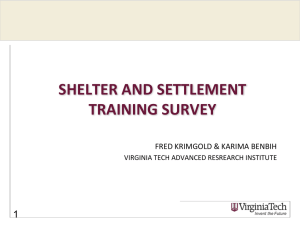Ethical and Legal Dilemmas in Shelter Medicine Wendy Blount, DVM
advertisement

Ethical and Legal Dilemmas in Shelter Medicine Wendy Blount, DVM Terms Immediate Supervision - a veterinarian required to immediately supervise a veterinarian must be within audible and visual range of both the animal patient and the person under supervision • (Rules Pertaining to the Practice of Vet Med, Tex Admin Code, Title 22, Part 24 , §573.80) Terms Direct Supervision - a veterinarian required to directly supervise a non-veterinarian must be physically present on the same premises as the person under supervision • (Rules Pertaining to the Practice of Vet Med, Tex Admin Code, Title 22, Part 24 , §573.80) • (Vet Lic Act, SubChA, §801.002) Terms General Supervision - a veterinarian required to generally supervise a non-veterinarian must be readily available to communicate with the person under supervision • (Rules Pertaining to the Practice of Vet Med, Tex Admin Code, Title 22, Part 24 , §573.80) • (Vet Lic Act, SubChA, §801.002) VCPR at Shelters • A Veterinarian may not delegate veterinary care and treatment duties to an employee unless a valid VCPR had been established . • A veterinarian may not delegate care and treatment duties to anyone who is not either a direct employee, licensed chiropractor or licensed equine dentist (Rules of Prof Conduct §573.10(a)) VCPR at Shelters • it has been the tradition of shelter vets to delegate intake processing to lay staff under general supervision • it is the standard of care in shelter medicine to do so • Until recently, it has been assumed that the herd medicine definition of “exam” applied to shelter veterinarians just as it applies to feedlot veterinarians • VCPR established by making regular visits to the premises VCPR at Shelters Letter from the Board Executive Director “The Board has always stated that an examination is required to establish a veterinarian-client-patient relationship. Section (b)(2) was placed within the statute for herd livestock management. The example contemplated by that language was a livestock feedlot where the veterinarian makes medically appropriate and timely visits to the premises on which the animal is kept. This subsection does not apply to shelters in the initial presentation of the animal at the shelter as the veterinarian had not previously made medically appropriate and timely visits to the premises on which the animal was kept prior to arriving at the shelter.“ VCPR at Shelters “After the time period for holding the animal has elapsed, usually three days and set by local ordinance, then the shelter may claim the animal is abandoned and the shelter is the owner. Under Texas law, an animal’s owner or a caretaker designated by the owner can perform acts of veterinary medicine on the animal without involving a veterinarian and without concern for establishing a veterinarian-clientpatient relationship, because the owners and caretakers are exempt from the Veterinary Licensing Act. Until that point, in order to perform any veterinary services on that animal, including rabies vaccinations, a veterinarian must conduct an examination on that animal to establish a veterinarian-client-patient relationship. “ VCPR at Shelters Dilemma 1: • Standard of care in shelter medicine requires vaccination and deworming on or before intake, according to guidelines published by AAHA (2011), AAFP (2006) and ASV (2010) • A shelter that takes in 25,000 animals a year would need a staff of 11 vets just to process intakes • The new Board position causes shelter vets to commit malpractice by making it impossible to adhere to standards of care without a board violation VCPR at Shelters Dilemma 2: • Shelters that have no vet can not process intakes according to ASV Shelter Guidelines • Their only solution is to pass local ordinances that establish ownership of shelter animals on intake • This takes the veterinarian completely out of veterinary care at these shelters • By trying to prevent dilution of VCPR In shelters, the board has managed to eliminate the VCPR altogether VCPR at Shelters TVMA Proposed Solution: • (a-1) For purposes of Subsection (a)(1), an animal shelter may be considered the caretaker of an animal regardless of whether the shelter owns the animal. • (b) (2) making medically appropriate and timely visits to the premises, including an animal shelter, where [on which] the animal is kept. Terms Releasing Agency - a public or private animal pound, shelter, or humane organization. The term does not include an individual who occasionally renders humane assistance or shelter in the individual's home to a dog or cat • (Health & Safety Code, Title 10, Ch 828, Sec 001) Terms Animal Shelter - a facility that keeps or legally impounds stray, homeless, abandoned, or unwanted animals • (Health & Safety Code, Title 10, Ch 823, Sec 001) Volunteer = staff according to the law • (Health & Safety Code, Title 10, Ch 826, Sec 001) Accountability for Shelter Vets There are no special exceptions to regulation for shelter vets • Employment by or contractual service to a nonprofit or municipal corporation does not exempt the veterinarian from any of the provisions of the Veterinary Licensing Act or the Board's rules (Rules of Prof Conduct §573.72) • Open Letter to Veterinarians Board Notes Accountability for Shelter Vets • A veterinarian is not only responsible for the actions of all employees that provide patient care, but also is subject to discipline if anything goes wrong, even if staff fail to follow orders or act without proper orders (Rules of Prof Conduct §573.10(c)) • A veterinarian is responsible for any acts a nonveterinarian employee commits within the scope of the employee's employment (Rules of Prof Conduct §573.11) Dilemma #1 – Persona Non-Profit grata You work for a private non-profit shelter, providing the following services: • Spay-neuter services for animals adopted from the shelter and animals owned by members of the public • Medical care for shelter animals • Wellness clinic for pets owned by the public Several members belonging to your local VMA get together and write you a letter, strongly objecting to your non-profit competing with tax paying practices. Dilemma #1 – Persona Non-Profit grata Issues: • Is it legal for a non-profit practice to directly compete with a for-profit practice? • Is it ethical for a non-profit practice to directly compete with a for-profit practice? • Do the services offered matter? • Does it matter if you screen for financial need? Dilemma #1 – Persona Non-Profit grata Is it legal for a non-profit practice to directly compete with a for-profit practice? • A veterinarian employed by a shelter may not perform nonemergency veterinary services other than sterilization on an animal that the shelter knows or should know has an owner that is not indigent (HASC TITLE 10,Ch 828,Sec 828.012(b)) • Animal Shelter - a facility that keeps or legally impounds stray, homeless, abandoned, or unwanted animals (Health & Safety Code, Title 10, Ch 823, Sec 001) Dilemma #1 – Persona Non-Profit grata Is it legal for a non-profit practice to directly compete with a for-profit practice? • Shelter vets can spay-neuter as they please, regardless of financial need • Shelter vets can provide emergency care as they please, regardless of financial need • In order to provide other veterinary Services, shelter vets must screen for financial need • Doesn’t apply to non-sheltering non-profits • Who enforces this? HASC - DSHS Dilemma #1 – Persona Non-Profit grata How do we go about screening for financial need? • HHS publishes poverty standards yearly • Many state aid programs have less stringent financial means tests • Financial Need Form • It’s easy – takes a few minutes • We do allow automatic admission without screening for defined areas predominantly spanish speaking Dilemma #1 – Persona Non-Profit grata Why is it ethically important to screen for financial need? • It keeps us from getting distracted from the mission of animal sheltering – to serve people and animals with the greatest need • There is much work to do in Texas • Any person/animal we help that would otherwise be helped keeps us from helping those with the greatest need Dilemma #1 – Persona Non-Profit grata Should we screen for financial need for spayneuter services? • Arguments against financial screening: – Models show that low and no cost spay-neuter services that do not screen for financial need are effective at achieving no-kill status in the community within 5-10 years if enough surgeries are done – These programs include those who can afford to but choose not to spay and neuter their pets Dilemma #1 – Persona Non-Profit grata Should we screen for financial need for spayneuter services? • Arguments for financial screening: – Chu et al, JAVMA 2009 – the single most important variable in predicting whether a family sterilizes their pets is household income – PetSmart Charities – 80-90% of pets owned by the indigent are not sterilized; 80-90% of the rest are sterilized – Euthanasias per capita are highest in areas with the highest poverty rates Dilemma #1 – Persona Non-Profit grata Should we screen for financial need for spayneuter services? • We have a hybrid (O’Malley PET): – We serve those who demonstrate financial need and pets owned by rescues and shelters who are not yet adopted – We generate funds and partner with our local Humane Society to subsidize spayneuter fees at for-profit local clinics for those who do not meet financial screening requirements Dilemma #2 – Shelter Staff Mutiny • You are a spay-neuter vet at your local shelter one day a week, serving pets adopted from the shelter, pets owned by shelters and rescues, and pets owned by those who demonstrate financial need • Though it is not in your job description and you are not paid for it, you often help with medical care of shelter animals as time permits • You have one shelter employee (tech) directly accountable to you, and a well trained volunteer surgical support staff Dilemma #2 – Shelter Staff Mutiny • When surgeries are completed for the day, your tech asks you to examine and prescribe treatment for a mom cat and her kittens, all suffering from URI • Mom cat is owned by the shelter and is being fostered by a surgical volunteer • Babies belong to a local cat rescue surgical volunteer works with • Mom accepts kittens and nurses them, all have URI • Volunteer fostering all calls you at 8pm 2 days later; one of the kittens is gasping Dilemma #2 – Shelter Staff Mutiny • Undercurrents – You each an online college course for 8 weeks once yearly – During that time, surgery numbers are reduced – You recently asked your tech of 4 months to reduce surgery numbers by 25% for 8 weeks – You arrange for a local vet to do the surgeries you will not be doing – She is mad at you Dilemma #2 – Shelter Staff Mutiny • Kitten is in respiratory distress • You try to get access to the tech office where the microscope and lab equipment are • The door is locked, and you do not have a key • You call the tech, the shelter director and the shelter manager, the latter who is on call 24-7365, and no one answers • The kitten dies the next day • Multiple messages to all three not answered Dilemma #2 – Shelter Staff Mutiny • 2 days later, you visit the shelter director and tell her that if the office is to be locked, you need a key for after hours access for emergency care • Shelter director declines to give you a key and does not know if you will get a key • Another surgery day passes by with no access – vet students do first surgeries ever on shelter animals – The closest EC is 90 miles away Dilemma #2 – Shelter Staff Mutiny Shelter director says you were not authorized to treat the kitten that was not owned by shelter, and therefore you should not have been there • The decision to accept an animal as a patient is at the sole discretion of a veterinarian (Rules of Prof Conduct §573.20(a)) • Shelter staff requested that you examine the kitten in presence of the owner’s designated caretaker, creating a binding VCPR • Your clinic serves pets owned by rescues Dilemma #2 – Shelter Staff Mutiny Shelter director says you were not authorized to be in the building that night, because you are on call for surgeries until noon the day after surgery • A person may not practice veterinary medicine unless a veterinarian-client-patient relationship exists. A veterinarian-clientpatient relationship exists if the veterinarian: – assumes responsibility for medical judgments regarding the health of an animal and a client, who is the owner or other caretaker of the animal, agrees to follow the veterinarian's instructions – possesses sufficient knowledge of the animal to initiate at least a general or preliminary diagnosis of the animal's medical condition; and – is readily available to provide, or has provided, follow-up medical care in the event of an adverse reaction to, or a failure of, the regimen of therapy provided by the veterinarian Dilemma #2 – Shelter Staff Mutiny Shelter director says you were not authorized to be in the building that night, because you are on call for surgeries until noon the day after surgery • Once a VCPR has been established, a veterinarian may discontinue treatment only under the following circumstances: – at the request of the client; – after the veterinarian substantially completes the treatment or diagnostics prescribed; – upon referral to another veterinarian; – or after notice to the client providing a reasonable period for the client to secure the services of another veterinarian (Rules of Prof Conduct §573.20(c)) Dilemma #2 – Shelter Staff Mutiny Shelter director says you can not have access to the tech’s office after hours because she needs her privacy • The professional services of the veterinarian shall not be controlled or exploited by any lay organization or person which intervenes between the client and the vet (Rules of Prof Conduct §573.21,Vet Lic Act SubChH, §801.352(a)) • A person associated with a shelter may not interfere with the independent professional judgment of a veterinarian employed by or under contract with the shelter (HASC TITLE 10,Ch 828,Sec 828.012(c)). Dilemma #2 – Shelter Staff Mutiny Shelter director says you can not have access to the tech’s office after hours because she needs her privacy • Veterinarians are prohibited from working in situations that interfere with practice • A veterinarian shall not allow or submit to a non-licensed person or entity to interfere or intervene with the licensee's practice. A vet shall avoid all relationships which could result in interference or intervention in the licensee's practice by a non-licensed person or entity (Rules of Prof Conduct §573.21,Vet Lic Act SubChH, §801.352(b)(c)) Dilemma #2 – Shelter Staff Mutiny Board Rules on Management Services • A veterinarian or group of veterinarians may contract with a management services organization to provide management services, so it OK for a shelter to pay lay people to manage a veterinary practice within a shelter (Rules of Prof Conduct §573.74(b)) • List of practices prohibited • List of practices permitted • In the TVMA Proceedings Medical Records When the veterinarian leaves the practice, he/she can either keep the medical records or transfer them to another vet • If the practice closes, the veterinarian can transfer ownership of records to another licensed veterinarian only if the veterinarian provides notice to owners and the veterinarian who assumes ownership of the records shall maintain the records consistent with this chapter (Rules of Prof Conduct §573.52(b)). Medical Records • The client is entitled to a copy of the patient records within 15 days (Rules of Prof Conduct §573.52(b),§573.54(a)). • Reasonable charges for copying, postage and writing summaries are allowed (Rules of Prof Conduct §573.54(c)) • records may not be withheld for unpaid balances (Rules of Prof Conduct §573.54(d)) • Patient records shall be current and readily available for a minimum of five years… It is unlawful to destroy medical records relating to unresolved legal proceedings (Rules of Prof Conduct §573.52(b)). Medical Records • Medical Records may not be released without the permission of the animal's owner (Rules of Prof Conduct §573.28,Vet Lic Act SubChH,§801.353) • Exceptions are court order, for debt collection, during a Board inspection, or to pass on rabies vaccination certificate or other information needed for a life threatening situation or public health purpose. • The easiest way to release records to vets when they call is to just put a permission to release records clause in the informed consent form for surgery, and make that a condition of doing low cost surgery. Dilemma 3 – Staff Plays Mini Doctor • You work for a shelter providing spay-neuter services • There is no budget for in house veterinary care of shelter animals • Shelter staff routinely administer booster vaccines, dispense dewormer, perform feline leukemia and heartworm tests, and treat URIs on recently adopted animals • What is your liability? Dilemma 3 – Staff Plays Mini Doctor • A person who is not a veterinarian may not diagnose animal diseases or conditions, or dispense medications unless prescribed by a veterinarian (Rules of Prof Conduct §573.10(d)(3)) • This is true even if the drugs and biologics are available over the counter Dilemma 3 – Staff Plays Mini Doctor • Practice of Veterinary Medicine: the diagnosis, treatment, correction, change, manipulation, relief, or prevention of animal disease, deformity, defect, injury, or other physical condition, including the prescription or administration of a drug, biologic, anesthetic, apparatus, or other therapeutic or diagnostic substance or technique (Vet Lic Act, SubChA, §801.002). Dilemma 3 – Staff Plays Mini Doctor • You inform shelter staff that they must stop diagnosing, prescribing for and treating owned animals • They tell you to mind your own business. You are the spay neuter vet and they don’t have to listen to what you way on other veterinary issues Dilemma 3 – Staff Plays Mini Doctor • A veterinarian is not only responsible for the actions of all employees that provide patient care, but also is subject to discipline if anything goes wrong, even if staff fail to follow orders or act without proper orders (Rules of Prof Conduct §573.10(c)) • A veterinarian is responsible for any acts a nonveterinarian employee commits within the scope of the employee's employment (Rules of Prof Conduct §573.11) Dilemma 4 – Mini Doctor Sequel • You are not a shelter vet • A local colleague gets wind that the shelter supervisor is treating heartworms in the shelter and has a Defcon Alert Meltdown • You recently diagnosed a shelter dog with heartworms in your practice, and prescribed Immiticide to for the shelter director to administer • The shelter director used to work For you as a tech and is well qualified to give 2 deep IM injections Dilemma 4 – Mini Doctor Sequel • The Veterinary Practice Act does not apply to care provided by an owner. • shelter staff can do just about anything they want to animals that they own, as long as they are using materials legally in their possession and the animals are treated humanely (Vet Lic Act, SubChA,§801.004(1)). • Things shelter staff may not do to animals they own: surgery and use prescription drugs not legally in their possession. VCPR Exceptions for Hospitalization • A non-veterinarian may, in the absence of direct supervision, follow the oral or written treatment orders of a veterinarian who is caring for a hospitalized animal, so long as the veterinarian has examined the animal(s) and a valid VCPR exists (Rules of Prof Conduct §573.10(g)) VCPR Exceptions for Emergency Care • In an emergency situation where prompt treatment is essential for the prevention of death or alleviation of extreme suffering, a veterinarian may, after determining the nature of the emergency and the condition of the animal, issue treatment directions to a non-veterinarian by means of telephone, electronic mail or messaging, radio, or facsimile communication (Rules of Prof Conduct §573.10(f)). • Shelter staff is permitted to, without expectation of compensation, provide emergency care in an emergency or disaster without supervision by a veterinarian if one is not available (Vet Lic Act SubCh A,§801.004(8)). Web Resources http://wendyblount.com • Click on “Presentation Notes” • Blount – the PowerPoint - .pptx and .pdf formats • Blount – Legal Cheat Sheet • Chu, JAVMA 2009 – income and spay-neuter • HASC.10.821 – Treatment of Animals in Shelters • HASC.10.822 - DangerousDogs Web Resources http://wendyblount.com • HASC.10.823 – Animal Shelters • HASC.10.825 – Animal Nuisances • HASC.10.826 - Rabies • HASC.10.828 - Dog and Cat Sterilization • HASC.10.829 – ACOs • HASC.25.169 – Zoonosis • HASC.481 - ControlledSubstances Web Resources http://wendyblount.com • TPC 2.09 – Cruelty to Animals • TSBVME - Required Notice to Clients • TSBVME – Notification for Temporary Clinic • Standards for Temporary Clinic (Proceedings) • Rules of Professional Conduct (Board Rules) • Veterinary Practice Act • Federal Controlled Substance Act








